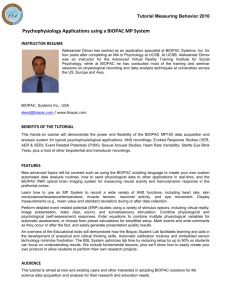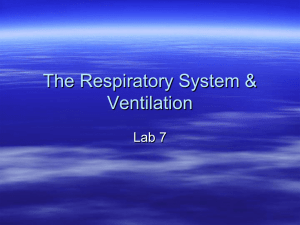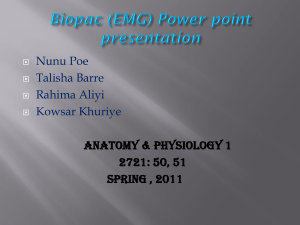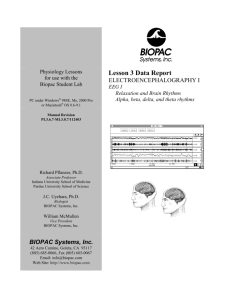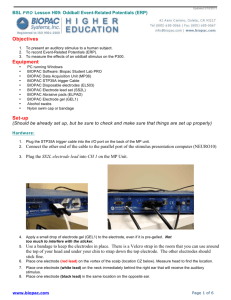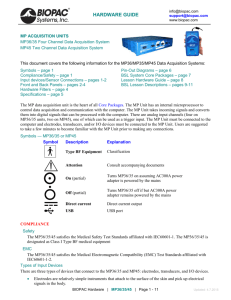VR Demo - Acrophobia (Elevator)
advertisement
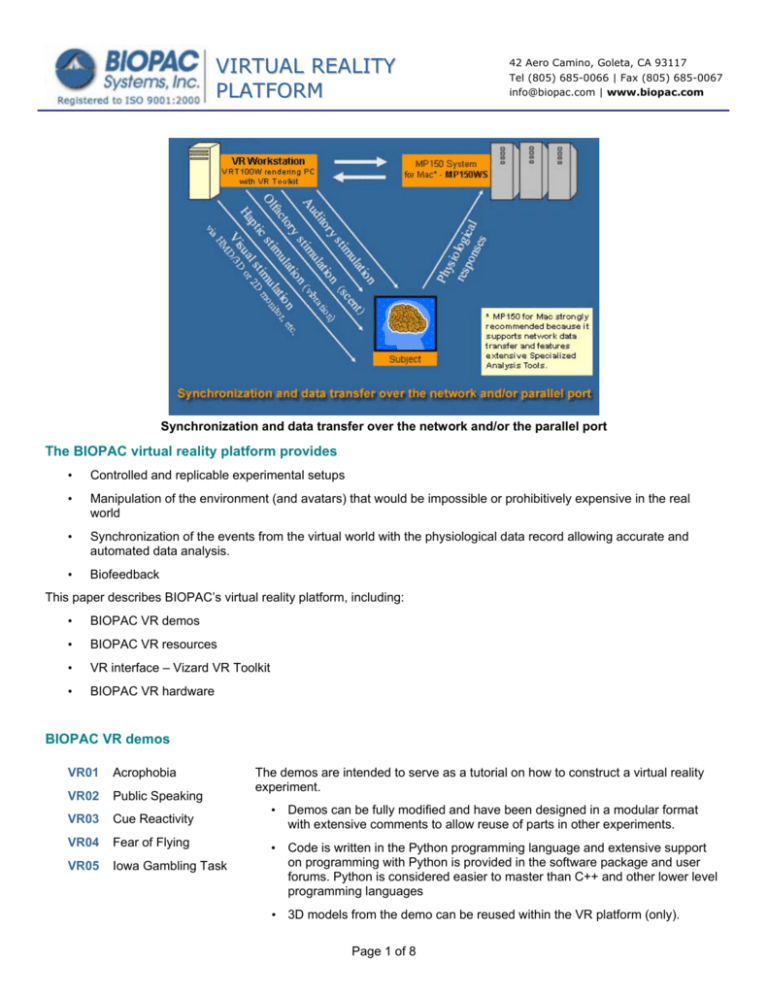
VIRTUAL REALITY PLATFORM 42 Aero Camino, Goleta, CA 93117 Tel (805) 685-0066 | Fax (805) 685-0067 info@biopac.com | www.biopac.com Synchronization and data transfer over the network and/or the parallel port The BIOPAC virtual reality platform provides • Controlled and replicable experimental setups • Manipulation of the environment (and avatars) that would be impossible or prohibitively expensive in the real world • Synchronization of the events from the virtual world with the physiological data record allowing accurate and automated data analysis. • Biofeedback This paper describes BIOPAC’s virtual reality platform, including: • BIOPAC VR demos • BIOPAC VR resources • VR interface – Vizard VR Toolkit • BIOPAC VR hardware BIOPAC VR demos VR01 Acrophobia VR02 Public Speaking VR03 Cue Reactivity VR04 Fear of Flying VR05 Iowa Gambling Task The demos are intended to serve as a tutorial on how to construct a virtual reality experiment. • Demos can be fully modified and have been designed in a modular format with extensive comments to allow reuse of parts in other experiments. • Code is written in the Python programming language and extensive support on programming with Python is provided in the software package and user forums. Python is considered easier to master than C++ and other lower level programming languages • 3D models from the demo can be reused within the VR platform (only). Page 1 of 8 BIOPAC Systems, Inc. Virtual Reality Platform www.biopac.com Virtual Reality Demo 01: ACROPHOBIA (FEAR OF HEIGHTS) In this demo, a participant is on a scaffold elevator in an environment designed to emphasize the perception of height. Movement can be controlled by the experimenter and/or the participant’s physiological responses. Screenshots of the environment Usage Guidelines This demo is also intended to serve as a tutorial on how to construct a virtual reality experiment. It can be fully modified and has been designed in a modular format with extensive comments to allow reuse of parts in other experiments. Code is written in the Python programming language and extensive support on programming with Python is provided in the software package and user forums. 3D models from the demo can be reused within the VR platform (only). Objectives 1. To expose the participant to different heights in a virtual environment. 2. To record the resulting physiological responses. Overview The participant is moving up on a scaffold elevator in an environment designed to emphasize the perception of height. Movement can be controlled by the experimenter and/or participant's physiological reactions. This demo is based on the work of Wilhelm et al (2005). There are seven “floors” for the elevator (different height levels). There are two modes of the experiment depending on what controls the vertical movement of the elevator: Participant-controlled—Progress to the next level is allowed only if there were no SCR responses in the last 20 seconds and the SCL level has not been rising for the last 20 sec. Experimenter-controlled—Progress to the next level is initiated by a keystroke from the experimenter. In the participant-controlled mode SCL data is sent from the data acquisition machine (ACQ) to the virtual reality rendering machine (VR). The responses are analyzed in real-time to determine when the participant should move to the next height level. In both experiment modes digital marker data is sent from VR to ACQ. Key events in the virtual world (i.e. going to a new height level) are marked in the physiological record to facilitate automatic data analysis. Data analysis Since levels of the independent variable (height of the participants) are marked in the physiological record, an automated analysis of the collected physiological data can be performed, identifying SCR responses for each height level. Bibliography This demo is based primarily on: Mechanisms of Virtual Reality Exposure Therapy: The Role of the Behavioral Activation and Behavioral Inhibition Systems. Applied Psychophysiology and Biofeedback, Vol. 30, No. 3, September 2005 (C 2005) DOI: 10.1007/s10484-005-6383-1. Frank H. Wilhelm,1,5 Monique C. Pfaltz,1 James J. Gross,2 Iris B. Mauss,2 Sun I. Kim,3 and Brenda K. Wiederhold4 Page 2 of 8 BIOPAC Systems, Inc. Virtual Reality Platform www.biopac.com Other literature: The development of virtual reality therapy (VRT) system for the treatment of acrophobia and therapeutic case. Jang DP, Ku JH, Choi YH, Wiederhold BK, Nam SW, Kim IY, Kim SI. IEEE Trans Inf Technol Biomed. 2002 Sep;6(3):213-7. Virtual Reality Treatment in Acrophobia: A Comparison with Exposure in Vivo P.M.G.Emmelkamp, M.Bruynzeel, L.Drost, C.A.P.G.van der Mast Cyberpsychology and Behavior, Vol.4, No.3, June 2001, pp.335-341 Treatment of acrophobia in Virtual Reality; the role of immersion and presence. Merel Krijn, Paul M. G. Emmelkamp, Roeline Biemond, Claudius de Wilde de Ligny, Martijn J. Schuemie and Charles A.P.G. van der Mast Behaviour Research and Therapy, 2004 Feb; 42(2):229-239. Virtual Reality Demo 02: PUBLIC SPEAKING In this demo, a social anxiety scenario, the participant delivers a speech in front of an audience. The audience attitude can be varied by the experimenter between different states (e.g., friendly, hostile, and indifferent). The number of avatars and room size can be controlled. Screenshots of the environment Usage Guidelines This demo is also intended to serve as a tutorial on how to construct a virtual reality experiment. It can be fully modified and has been designed in a modular format with extensive comments to allow reuse of parts in other experiments. Code is written in the Python programming language and extensive support on programming with Python is provided in the software package and user forums. 3D models from the demo can be reused within the VR platform (only). Objectives 1. To set up a virtual world where the participant can give a speech in front of a virtual audience. 2. To record the physiological responses of the participant as parameters like audience behavior, room size and audience size are varied. Overview The participant delivers a speech from behind a podium. The speech text is presented on a monitor on the podium and can be scrolled via a joystick. The room size and number of people (and whether the people are present in the room) are conditions set in advance. During the experiment, the researcher can switch the audience state – e.g., make the audience display boredom, disapproval, etc. Audience behavior is defined using avatar animations and is not limited to the animations included with the demo. Data analysis The current state of the audience is marked in the physiological data record, which enables automatic scoring of the data. Bibliography Brief Virtual Reality Therapy for Public Speaking Anxiety Dec 2002, Vol. 5, No. 6 : 543 -550 Speaking anxiety using virtual reality for exposure. Depression and Anxiety 2005;22(3):156-8 An Experiment on Public Speaking Anxiety in Response to Three Different Types of Virtual Audience DP Pertaub, M Slater, C Barker - Presence: Teleoperators & Virtual Environments, 2002 An experimental study on fear of public speaking using a virtual environment. Cyberpsychol Behav. 2006 Oct;9(5):627-33. Slater M, Pertaub DP, Barker C, Clark DM. Page 3 of 8 BIOPAC Systems, Inc. Virtual Reality Demo 03: Virtual Reality Platform www.biopac.com CUE REACTIVITY In this demo, the participant is exposed to a sequence of rooms along a corridor that contain different stimulation environments. Four neutral environments and four smoking environments are included. Usage Guidelines This demo is also intended to serve as a tutorial on how to construct a virtual reality experiment. It can be fully modified and has been designed in a modular format with extensive comments to allow reuse of parts in other experiments. Code is written in the Python programming language and extensive support on programming with Python is provided in the software package and user forums. 3D models from the demo can be reused within the VR platform (only). Objectives 1. To use a controlled stimulus presentation where the participant is exposed to environments with different stimuli. 2. To record the physiological responses. For example, in the study of addictions, this paradigm could be used to investigate the relationship between craving, physiological response, and the way the stimulus is presented in the environment. Overview The participant is exposed to a sequence of rooms along a corridor that contain different stimulation environments. Four neutral environments and four smoking environments are included, and the environment can be expanded. The number of rooms as well as the objects in the rooms can be modified. The participant does not actively navigate the environment. Data analysis Digital markers in the physiological record indicate when the participant is exposed to what condition, which allows for automated data analysis. Bibliography Virtual Reality Cue Reactivity Assessment: A Case Study in a Teen Smoker Authors: Bordnick, Patrick; Traylor, Amy; Graap, Ken; Copp, Hilary; Brooks, Jeremy Source: Applied Psychophysiology and Biofeedback, Volume 30, Number 3, September 2005, pp. 187-193(7) Virtual Reality Cue Reactivity Assessment in Cigarette Smokers Patrick S. Bordnick, Ken M. Graap, Hilary Copp, Jeremy Brooks, Mirtha Ferrer, Cyberpsychology & Behavior. Volume 8, Number 5, 2005 Virtual Reality Demo 04: FEAR OF FLYING In this demo, the participant is seated in an airplane and experiences normal flight, turbulence, and landing. Tactile feedback is employed to increase the experience of presence. Page 4 of 8 BIOPAC Systems, Inc. Virtual Reality Platform www.biopac.com Screenshots of the environment Usage Guidelines This demo is also intended to serve as a tutorial on how to construct a virtual reality experiment. It can be fully modified and has been designed in a modular format with extensive comments to allow reuse of parts in other experiments. Code is written in the Python programming language and extensive support on programming with Python is provided in the software package and user forums. 3D models from the demo can be reused within the VR platform (only). Objectives 1. Expose participants to an airplane environment. 2. Record their physiological responses to different aspects of the experience of being in an airplane. Overview Participants are immersed in a virtual environment where they are seated in an airplane and experience normal flight, turbulence, and a landing. Tactile feedback is employed (a low-frequency driver is placed underneath the chair) to increase the experience of presence. The experimenter can trigger certain events (e.g. landing sequence, turbulence, cabin announcements, etc.). Data analysis All events are marked in the physiological record, which facilitates automated data analysis. Bibliography: Cognitive behavior therapy for fear of flying: Sustainability of treatment gains after September 11.Anderson, P., Jacobs, C. H., Lindner, G. K., Edwards, S., Zimand, E., Hodges, L. F., & Rothbaum, B. O. Behavior Therapy 37 (2006) 91-97 Three-Year Follow-Up for Virtual Reality Exposure for Fear of Flying. Wiederhold, B.K. (2003) Wiederhold, M.D. CyberPsychology & Behavior: The Impact of the Internet, Multimedia and Virtual Reality on Behavior and Society. Vol 6(4). pp 441-445. Virtual Reality Treatment of Flying Phobia. Rosa M. Baños, Cristina Botella, Concepción Perpiñá, Mariano Alcañiz, Jose Antonio Lozano, Jorge Osma, and Myriam Gallardo. IEEE Transactions on Information Technology in Biomedicine, vol. 6, no. 3, September 2002. Virtual Reality Demo 05: IOWA GAMBLING TASK In this demo, participants follow the Iowa Gambling Task, a classic experiment in which participants choose between decks of cards with different payoffs. The skin conductance response before and after making a choice can be easily analyzed due to the marking of events from the experiment in the physiological record. In addition, the appearance of the decks, assigned probabilities of winning and losing, can be modified. Usage Guidelines This demo is also intended to serve as a tutorial on how to construct a virtual reality experiment. It can be fully modified and has been designed in a modular format with extensive comments to allow reuse of parts in other experiments. Code is written in the Python programming language and extensive support on programming with Python is provided in the software package and user forums. 3D models from the demo can be reused within the VR platform (only). Objectives 1. To use the Iowa Gambling Task template, a hypothesis testing tool modeled after the work of Bechara et al (1994). 2. To record skin conductance before and after the choice. Page 5 of 8 BIOPAC Systems, Inc. Virtual Reality Platform www.biopac.com Overview Quote and graph taken from Bechara et al (2005): “The participants are given four decks of cards, a loan of $2000 facsimile US bills, and asked to play so as to win the most money. Turning each card carries an immediate reward ($100 in decks A and B and $50 in decks C and D). Unpredictably, however, the turning of some cards also carries a penalty (which is large in decks A and B and small in decks C and D). Playing mostly from decks A and B leads to an overall loss. Playing from decks C and D leads to an overall gain. The players cannot predict when a penalty will occur, nor calculate with precision the net gain or loss from each deck. They also do not know how many cards must be turned before the end of the game (the game in fact ends after 100 card selections).” Taken from: The Iowa Gambling Task and the somatic marker hypothesis: some questions and answers A. Bechara, H. Damasio, D. Tranel and A.R. Damasio TRENDS in Cognitive Sciences Vol.9 No.4 April 2005 Anticipatory SCR levels change as a function of the number of trials experienced and result in an increasing disparity between levels observed prior to selecting good vs. bad decks. Bechara et al have proposed that this change in somatic response occurs even before the participants have adequate conscious knowledge of the situation. Data analysis With minor customization, this demo application can be directly applied for research or teaching purposes. It allows the user to test the following: 1. Are somatic responses different before and after good vs. bad decks? 2. Are somatic responses different for more vs. less predictable decks (defined as low vs. high variance in outcome)? 3. How do 1, 2 change as a function of time? Bibliography The Iowa Gambling Task and the somatic marker hypothesis: some questions and answers A. Bechara, H. Damasio, D. Tranel and A.R. Damasio. TRENDS in Cognitive Sciences Vol.9 No.4 April 2005 Insensitivity to future consequences following damage to human prefrontal cortex. Bechara, A., Damasio, A. R., Damasio, H. & Anderson, S. W. (1994) Cognition50, 7–15. Do somatic markers mediate decisions on the gambling task? Tomb, I., Hauser, M., Deldin, P. & Caramazza, A. (2002) Nat. Neuroscience. 5, 1103–1104. Cleeremans, A. (2001) in International Encyclopedia of the Social & Behavioral Sciences, eds. Smelser, N. J. & Baltes, P. B. (Elsevier, London), Vol. 4, pp.2584–2589. Implicit Learning: News From the Front. Cleeremans, A., Destrebecqz, A. & Boyer, M. (1998) Trends Cogn. Sci. 2, 406–416. Page 6 of 8 BIOPAC Systems, Inc. Virtual Reality Platform www.biopac.com VR resources (in progress) • 3D model library for the BIOPAC VR platform; models can be used within the VR platform only. Alcohol - beer bottle - hard liquor bottle - wine bottle Auditorium Ball Bathroom Bookshelf Buildings Bus Car Card deck with 52 objects • Cardboard box Chair Classroom Computer Desk Dice Dresser Living room Monitor Office cubicle Overpass scene Sound library VR Interface Use the WorldViz Vizard Virtual Reality Toolkit with your BIOPAC data acquisition and analysis system to synchronize events from the virtual world with the physiological data record, allowing accurate and automated data analysis. Vizard VR Toolkit is everything you need to build complete, interactive 3D content. Designed for rapid prototyping, Vizard gets you creating fast and provides the resources to deploy even the most challenging applications. With Vizard, even someone with no programming experience can leap into the world of interactive 3D content and soon discover what it's like to have an untethered imagination. Page 7 of 8 Pit room Podium Road – curved segment – straight segment Sky dome Soda can Sofa Table TV BIOPAC Systems, Inc. Virtual Reality Platform www.biopac.com VR Hardware • • HDS100 Haptic delivery system SDS100 Scent delivery system • SDSAIR air compressor for SDS100 • • HMD1 Head-mounted display HMD2 Head-mounted display (high res) HDS100 Haptic delivery system Haptic delivery system for tactile feedback during VR experiments. The system includes an amplifier that connects to a computer sound card and a pair of actuators that vibrate based on the sound from the sound card. Actuators are placed under chair legs or on a platform and deliver vibrations based on the VR environment—i.e., movement of elevators. SDS100 Scent delivery system Computer controlled (USB) 8 cartridge scent machine that uses compressed air* to project different scents on cue for a predetermined time…followed by a burst of unscented air to clear for the next scent. Scents are triggered from the virtual reality environment. Dispersed scent covers approximately 3-6 meters in front of unit, depending on how many fans are used. • Requires companion air compressor, SDSAIR or equivalent HMD1 Head-mounted display Two high-contrast microdisplays (SVGA 3D OLED) deliver fluid full-motion video in more than 16.7 million colors. The highly responsive head-tracking system provides a full 360-degree angle of view and specially developed optics deliver a bright, crisp image with a nearly 40 deg field of view HMD2 Head-mounted display (high res) State-of-the-art head-mounted display (HMD) for advanced virtual reality applications. Incorporates high-resolution color microdisplays with custom engineered optics to deliver unsurpassed visual acuity in a wide field-of-view format. Page 8 of 8
